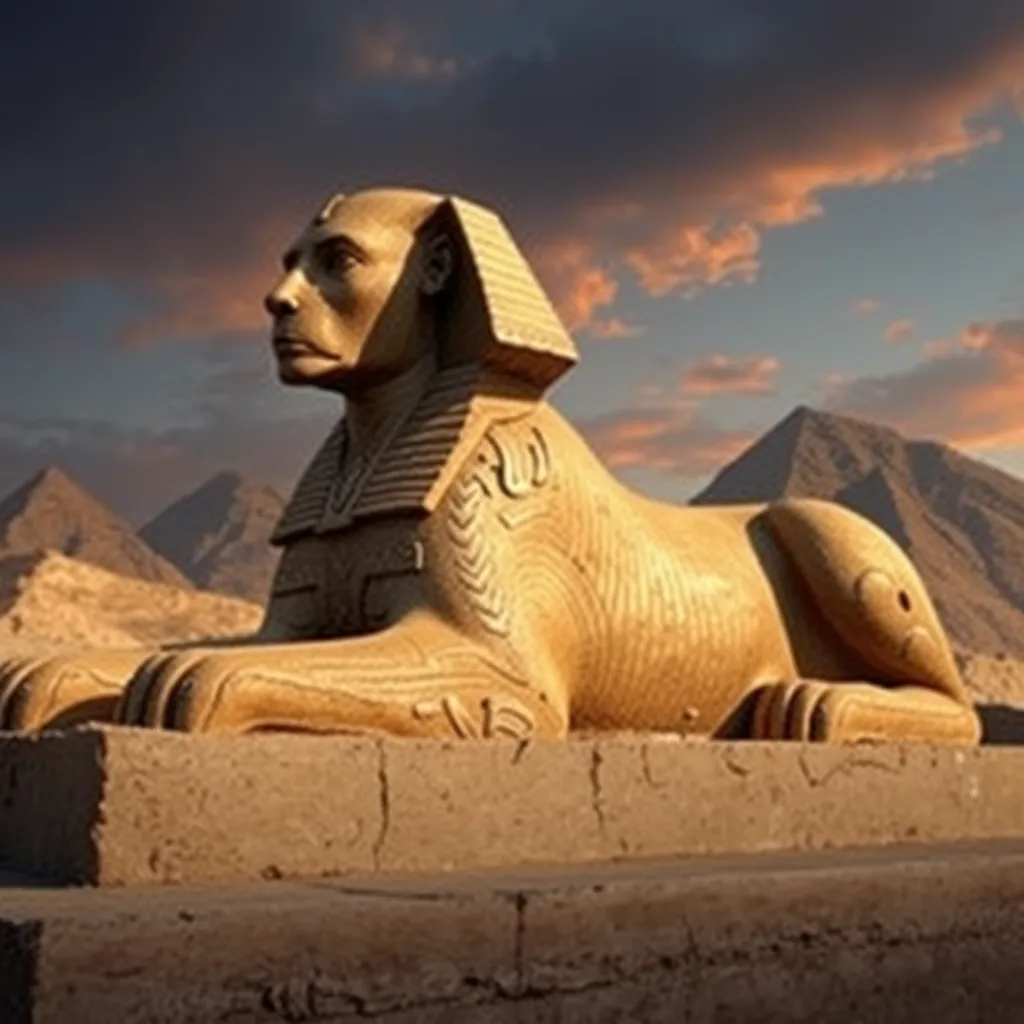Sphinx in Greek Art and Literature: Exploring its Representations
I. Introduction
The Sphinx is a fascinating creature that occupies a prominent place in Greek mythology. Defined as a mythical being with the body of a lion and the head of a human, the Sphinx embodies both strength and enigma. Its significance extends beyond mere mythology; it serves as a powerful symbol in various cultural and artistic contexts throughout history.
This article delves into the multifaceted representations of the Sphinx in Greek art and literature. It will explore the origins and historical context of the Sphinx, its portrayal in literary works, artistic representations, and its enduring symbolism. The article aims to provide a comprehensive overview of the Sphinx’s role in ancient Greek society and its lasting impact on modern culture.
II. Historical Context of the Sphinx
A. Origins of the Sphinx in ancient Greek mythology
The Sphinx first emerged in Greek mythology as a creature associated with riddles and mysteries. According to legend, it was sent to plague the city of Thebes, posing a riddle to its inhabitants. Those who failed to solve it were met with dire consequences. The tale of the Sphinx is closely linked to that of Oedipus, who ultimately solved the riddle and freed Thebes from her grasp.
B. The Sphinx’s role in Greek culture and society
The Sphinx symbolized both a threat and a guardian figure in Greek culture. As a guardian, it often appeared in art and architecture, protecting sacred spaces and tombs. Its dual nature reflects the complexities of Greek beliefs about fate, knowledge, and the human condition.
C. Influence of Egyptian and Near Eastern sphinx representations
The Greek Sphinx was not an isolated phenomenon; it drew inspiration from earlier representations found in Egyptian and Near Eastern art. The Egyptian sphinx, typically depicted as a lion with a human head, served as a royal symbol, whereas the Greek Sphinx adopted a more enigmatic and challenging persona. This cross-cultural exchange enriched the Greek interpretation of the Sphinx and contributed to its complexity.
III. The Sphinx in Greek Literature
A. The Sphinx in Homer’s works
While the Sphinx is not a central figure in Homer’s epics, it is alluded to in the context of Thebes and the tales surrounding Oedipus. The absence of detailed descriptions emphasizes the Sphinx’s role as a cryptic figure, representing the unknown and the challenges faced by heroes.
B. Representations in Sophocles’ “Oedipus Rex”
In Sophocles’ “Oedipus Rex,” the Sphinx plays a pivotal role. The famous riddle, “What walks on four legs in the morning, two legs at noon, and three legs in the evening?” serves as a central motif. Oedipus’s ability to solve the riddle not only underscores his intelligence but also foreshadows his tragic downfall, linking knowledge with fate and suffering.
C. Symbolism and themes associated with the Sphinx in various texts
- Knowledge and Ignorance: The Sphinx embodies the tension between knowledge and ignorance, challenging characters to confront their limitations.
- Fate and Free Will: The Sphinx’s riddles often reflect the struggle between fate and the choices individuals make.
- Identity and Transformation: The Sphinx’s dual nature prompts questions about identity, representing both the human and the beast within.
IV. Artistic Representations of the Sphinx
A. Overview of Sphinx imagery in Greek pottery
The Sphinx is frequently depicted in Greek pottery, often portrayed in dynamic poses that emphasize its mythical qualities. These representations range from intricate black-figure vases to red-figure pottery, showcasing the Sphinx in various contexts, such as funerary art and mythological scenes.
B. Notable sculptures and their significance
One of the most notable sculptures of the Sphinx is the monumental Sphinx of Naxos, which was dedicated to Apollo. This large-scale sculpture exemplifies the artistic skill of the Greeks and serves as a testament to the Sphinx’s importance as a guardian figure in religious contexts.
C. The Sphinx in reliefs and architectural elements
The Sphinx also appears in architectural reliefs, often adorning temples and public buildings. These representations not only showcase artistic prowess but also reinforce the Sphinx’s role as a protector of sacred spaces.
V. Symbolism and Interpretation
A. The duality of the Sphinx as a symbol of wisdom and mystery
The Sphinx’s enigmatic nature embodies the duality of wisdom and mystery. It challenges individuals to seek knowledge while simultaneously reminding them of the limits of human understanding.
B. The Sphinx’s role as a guardian and a challenger
As a guardian, the Sphinx protects sacred realms, but as a challenger, it poses questions that must be answered. This dual role reflects the complexities of existence, where knowledge brings both enlightenment and peril.
C. Psychological and philosophical interpretations in art and literature
Psychologically, the Sphinx can be seen as a representation of the unconscious mind, embodying the fears and mysteries that lie within. Philosophically, it raises questions about the nature of existence, knowledge, and the human condition, inviting deeper exploration of these themes in both art and literature.
VI. Comparative Analysis
A. Comparison with representations of the Sphinx in other cultures
Comparing Greek representations of the Sphinx with those in Egyptian and Mesopotamian cultures reveals significant differences in symbolism. While the Egyptian sphinx often symbolizes royal power and protection, the Greek Sphinx leans more towards the themes of knowledge and challenge.
B. Influence of Greek Sphinx depictions on later artistic movements
The influence of Greek Sphinx depictions can be seen in later artistic movements, particularly during the Renaissance, when artists revisited classical themes. The Sphinx reappears in literature and art as a symbol of mystery and knowledge.
C. Cross-cultural themes and their relevance in contemporary discussions
Cross-cultural themes surrounding the Sphinx continue to resonate today, particularly in discussions about identity, knowledge, and the nature of challenges faced by individuals in modern society. These themes invite ongoing dialogue and exploration in various fields, including psychology, philosophy, and the arts.
VII. The Sphinx in Modern Culture
A. The legacy of the Sphinx in modern literature and art
The Sphinx’s legacy persists in modern literature and art, appearing in works that explore similar themes of mystery, identity, and knowledge. Writers and artists continue to draw inspiration from this ancient figure, reinterpreting its significance for contemporary audiences.
B. The Sphinx as a symbol in popular culture and media
In popular culture, the Sphinx has become a symbol of enigma and challenge, often appearing in films, novels, and video games. Its image evokes curiosity and intrigue, reinforcing its status as a timeless symbol.
C. Continuing fascination and reinterpretation in contemporary contexts
The fascination with the Sphinx endures, as contemporary artists and writers reinterpret its symbolism in light of modern existential questions. This ongoing engagement with the Sphinx reflects its adaptability and relevance across time and cultures.
VIII. Conclusion
In summary, the Sphinx holds a significant place in Greek art and literature, representing the complex interplay of knowledge, mystery, and identity. Its origins in Greek mythology, literary portrayals, and artistic representations reveal a rich tapestry of meanings that continue to resonate today.
The enduring significance of the Sphinx invites further exploration and research, encouraging scholars and enthusiasts alike to delve deeper into its multifaceted representations and implications in both ancient and modern contexts.




